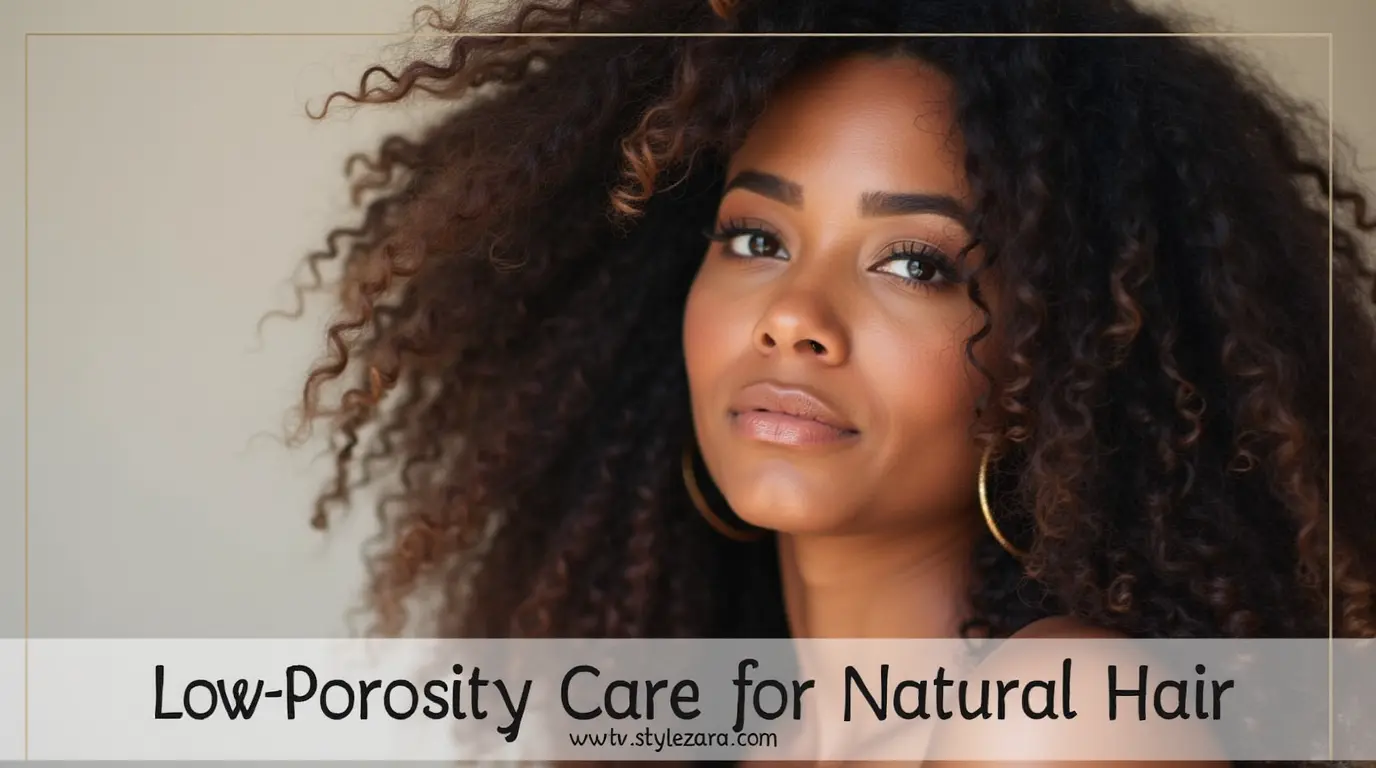Low-Porosity Care for Natural Hair: The Secret to Healthy Strands Unveiled

Transitioning From Relaxed to Natural hair is a powerful, transformative journey for many. Along the way, understanding your hair’s porosity—its ability to absorb and retain moisture—becomes a critical aspect of care. For those with low-porosity hair, this knowledge is especially crucial, as it directly impacts how products are absorbed and how moisture is maintained. In this article, we dive deep into the art and science of Low-Porosity Care for Natural Hair, uncovering the secrets to nurturing your tresses into optimal health.
Key Takeaways
- Low-porosity hair has tightly closed cuticles, making it difficult for moisture and products to penetrate.
- Choosing the right natural treatments and techniques is essential for maintaining moisture and reducing product buildup.
- Heat is your friend—using steam or warm treatments can help open the cuticle for better absorption.
- Low-porosity hair requires lightweight, water-based products that won’t weigh it down.
- Protective styling and regular care rituals are crucial to ensure healthy, thriving natural hair.
Understanding Low-Porosity Hair
Low-porosity hair is characterized by tightly bound cuticles that lie flat and overlap, creating a surface resistant to moisture absorption. While this structure provides natural protection, it also makes hydration challenging. Water and Natural Hair Treatments struggle to penetrate the cuticle, leaving the hair prone to dryness. However, with the right care strategies, low-porosity hair can flourish.
Signs You Have Low-Porosity Hair
One of the easiest ways to determine if you have low-porosity hair is through a water test. Drop a clean strand of hair into a glass of water. If it floats for an extended period without sinking, you likely have low-porosity hair. Other indicators include:
- Products sit on top of your hair without absorbing.
- Hair takes a long time to dry.
- Protein treatments tend to leave your hair feeling stiff and straw-like.
The Importance of Moisture in Low-Porosity Hair
Because the cuticles are so tightly sealed, moisture has difficulty getting inside the hair shaft. This can leave your hair feeling dry even after using hydrating products. The key is not just applying moisture but ensuring it penetrates the strands effectively. Using steam treatments or incorporating heat can help open the cuticle slightly, allowing moisture to seep in.
Table: Characteristics of Different Hair Porosities
| Hair Porosity | Characteristics | Best Care Practices |
|---|---|---|
| Low-Porosity | Tightly closed cuticles, moisture resistant | Use heat to open cuticles, lightweight products |
| Medium-Porosity | Balanced moisture absorption and retention | Moisturize regularly, avoid heavy products |
| High-Porosity | Open cuticles, prone to moisture loss | Deep conditioning, use sealing oils |
Why Protein Treatments Are Not Always Beneficial

Although protein treatments can strengthen hair, they aren’t always suitable for low-porosity hair. The proteins can sit on top of the hair shaft, creating stiffness rather than improving elasticity. Instead, opt for Natural Hair Treatments like aloe vera or honey-based deep conditioners, which help to soften the hair without adding excess protein.
Choosing the Right Products for Low-Porosity Hair
Selecting the right products for low-porosity hair is essential. Focus on lightweight, water-based products that don’t weigh down your strands. Avoid heavy butters and oils, as these can form a barrier on your hair, preventing moisture from entering. Look for humectants like glycerin, which help to draw moisture into the hair shaft.
Tips for Selecting Products:
- Water-based leave-ins: These penetrate better than oil-based alternatives.
- Humectants: Ingredients like honey and glycerin help pull moisture into the hair.
- Clarifying shampoos: Regular use of clarifying shampoos can remove product buildup.
Heat as a Tool for Moisture
One of the most effective ways to care for low-porosity hair is by using heat. This doesn’t mean excessive blow-drying or flat ironing, but rather gentle heat in the form of steam or warm water treatments. A steam treatment opens the cuticle, allowing moisture and products to penetrate deeply, which is a game changer for low-porosity hair.
Essential Hair Care Tips for Natural Hair
- Pre-poo treatments: Using lightweight oils or conditioners before shampooing helps soften the hair and prevent excessive moisture loss during cleansing.
- Warm water rinses: Always use warm water when rinsing your hair. Cold water can close the cuticle too tightly, making it hard for your conditioner to be effective.
- Layering techniques: After applying a water-based leave-in, follow up with a light oil to lock in moisture without overwhelming the strands.
Low-Porosity Hair Styling Do’s and Don’ts
When it comes to styling low-porosity hair, simplicity is key. Overloading the hair with too many products can lead to build-up, making it even harder for moisture to penetrate. Protective styles like twists or braids can help preserve moisture and reduce manipulation.
Do:
- Use minimal, lightweight styling products.
- Incorporate regular moisturizing treatments.
Don’t:
- Layer too many heavy oils or butters.
- Skip clarifying your hair regularly to remove product buildup.
Deep Conditioning Rituals
Deep conditioning is vital for maintaining the moisture balance in low-porosity hair. Opt for deep conditioners with lightweight oils and humectants, and always apply heat, such as a steam cap or warm towel, to ensure the product penetrates the cuticle.
Low-Porosity Care Routine Example
- Shampoo: Begin with a sulfate-free clarifying shampoo once a week to remove buildup.
- Deep Condition: Apply a moisturizing deep conditioner and cover with a steam cap for 20-30 minutes.
- Leave-In Conditioner: Use a lightweight, water-based leave-in conditioner to moisturize.
- Seal: Lightly seal with a thin oil like argan or grapeseed oil to lock in the moisture.
- Protective Style: Twist or braid your hair to retain moisture and reduce daily manipulation.
Understanding Low-Porosity Hair in Different Climates
Climate can also affect low-porosity hair. In humid climates, you may need fewer humectants, as the air is already moisture rich. In dry climates, on the other hand, using products with humectants like glycerin can help retain moisture.
FAQ
1. Can I use heavy oils like castor oil on low-porosity hair?
No, heavy oils can sit on top of the hair and prevent moisture from entering. Opt for lighter oils like grapeseed or argan oil.
2. How often should I clarify my low-porosity hair?
You should clarify your hair every 4-6 weeks to prevent buildup, depending on how much product you use.
3. Is protein necessary for low-porosity hair?
Low-porosity hair does not typically need regular protein treatments. Instead, focus on moisturizing treatments to keep hair soft and hydrated.
4. How can I tell if a product is too heavy for my hair?
If a product leaves a greasy film on your hair or takes a long time to absorb, it’s likely too heavy for low-porosity hair.
5. Can I color my low-porosity hair?
Yes, but ensure you moisturize and deep condition regularly, as low-porosity hair can struggle with absorbing and retaining moisture after chemical treatments.
Mastering Low-Porosity Care for Natural Hair requires patience and attention, but with the right knowledge and products, your hair can thrive. Balancing hydration, using heat strategically, and incorporating Essential Hair Care Tips for Natural Hair are key to unlocking your hair’s potential.

